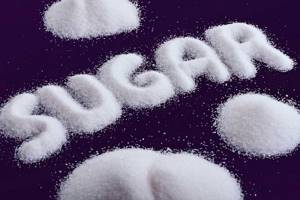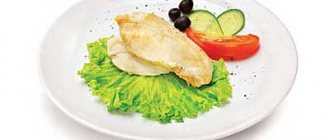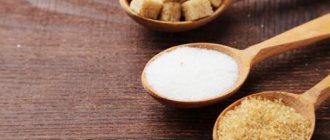Many people cannot imagine their existence without sugar. After all, various sweets such as candies, pastries, chocolate and cakes can not only satisfy the feeling of hunger, but also lift your spirits.
Sugar consists of active carbohydrates, which in turn play an important role in the process of saturating the body with various nutrients and releasing the energy necessary for all vital processes. In addition, sucrose is capable of breaking down easily digestible glucose in a fairly short period of time.
At the same time, the caloric content of sugar scares those who carefully monitor their weight or are trying to get rid of a few extra pounds. That is why many are interested in the question, how many calories are in a spoonful of sugar?
Glycemic index of sugar
The glycemic index refers to the rate of absorption and increase in blood sugar levels after consuming a product. The maximum glycemic index level is 100 for high-carbohydrate foods. Their consumption disrupts metabolic processes and leads to fat deposits. The minimum level is 0 for carbohydrate-free, fiber-rich foods that take a long time to be absorbed by the body and this process requires energy.
The glycemic index of sugar, white or brown, is 70, which is significantly lower than that of bread, potatoes, rice, pumpkin and watermelon.
Table of calorie content and nutritional value of different types of sugar
| Name | Calorie content | BZHU for 100 g | ||
| Squirrels | Fats | Carbohydrates | ||
| White (refined) sugar | 398 | 99,7 | ||
| Cane sugar | 385 | 0,21 | 0,04 | 97,61 |
| Coconut sugar | 376 | 1,1 | 0,5 | 94 |
Which sugar is healthier?
Sugar can come in different shapes and colors depending on the technology used to extract it. There is no fundamental difference in the beneficial properties of refined sugar, crystalline powder or powdered sugar. These three varieties are simply different forms of the same product. There are only differences in the optimal storage conditions for each of them. The level of sucrose in these products reaches 99.75% due to the high level of beet purification, the remaining 0.25% is all that remains for useful microelements. All nutritionists and doctors are unanimous in the opinion that sugar is not a healthy product and its only advantage is pure sweetness without background tastes and odors.

Brown cane sugar is less refined; the level of sucrose in it reaches 96%, the remaining 4% is moisture and molasses. It is a few percent of molasses that contains useful microelements. Well-known nutritionists have proven that brown sugar is much safer for tooth enamel and has a better effect on performance. To recognize this product on store shelves, you need to read the label. There must be the word “unrefined” and the type of sugar indicated. The most common: turbinado and muscovado.
In addition to real brown sugar, you can find white sugar, tinted by the manufacturer with molasses. This is a deception for the consumer who is incompetent in food products. If you compare it with white, then it is more useful due to the composition of molasses, if with brown, it is more harmful. They are not allowed to write “unrefined” on the label of this product; it can be recognized by this label.
Calorie content of cane sugar
Cane sugar is brown in color and has a lower calorie content than regular sugar. 100 g of product contains 385 kcal. It also has a lower glycemic index: 55 instead of 65 units. But this is provided that you bought a natural product and not a fake.

Photo source: shutterstock.com
The BZHU indicators are as follows:
- proteins - 0.21 g;
- fats - 0.04 g;
- carbohydrates - 97.61 gr.
At the same time, cane sugar has a rich composition of useful elements. Among them are B vitamins, calcium, potassium, magnesium, and sodium compounds.
Calorie content of a piece
Sometimes you can see cubed cane sugar on store shelves. So, 1 pc. on average weighs 4 grams, but there are pieces weighing 5 grams. Accordingly, the calorie content of a piece of cane sugar varies from 15.4 to 19.25 kcal.
How many calories are in a spoonful of sugar?
If eating without sugar is not possible, then it would not hurt to know the energy value in addition to its uselessness and glycemic index. Many nutritionists argue that it is not sugar itself that is harmful, but its excessive consumption in conditions of insufficient physical activity.
The table shows average data for white and brown sugar in the form of sand.
| Spoon | Brown | White |
| Dining room | From 80 without a slide to 86 with a slide | From 82 without a slide to 90 with a slide |
| Tea room with slide | From 18 without a slide to 26 with a slide | From 20 without a slide to 28 with a slide |
Calorie content of sugar
Our usual white (refined) granulated sugar contains 398 kcal per 100 grams. There are no proteins or fats in it, and the amount of carbohydrates is 99.7 g per 100 g of product.
How many calories are in a spoonful of sugar?
1 gram of sugar contains 3.98 kcal, and a teaspoon contains 5 grams of sugar without a slide. It turns out that the calorie content of 1 level teaspoon of sugar is 19.9 kcal. Also at 1 o'clock. l. Place 7 grams of sugar with a slide. Accordingly, its calorie content is 27.86 kcal.
But one tablespoon contains 14 grams of white sugar without a slide. Accordingly, its calorie content is 55.72 kcal. Also in 1 tbsp. l. fits 22 grams of sugar with a slide. This means that its calorie content is 87.56 kcal.
How many calories are in a glass of sugar
One 250 ml glass of sugar contains 225 grams of sugar. It is easy to calculate that a glass of sugar contains 895 kcal.
Brown sugar
No matter how paradoxical it may sound, in the context of the development of the modern food industry, brown sugar can be real, that is, unrefined, and fake, that is, tinted refined.
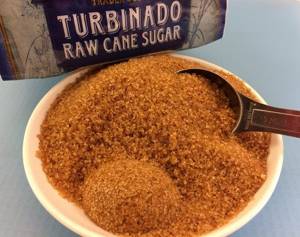
In the first case, sugar has beneficial properties due to the small but still present amount of molasses in it. It contains phosphorus, iron, potassium, calcium and sodium. In fact, it is an intermediate product at the stage of extracting white sugar.
Until recently, brown sugar was used primarily for the production of alcoholic beverages and some food products. But in recent decades, supporters of a healthy diet have begun to use it in their daily home menu. Experts say that its calorie content is identical to the calorie content of white sugar, but consuming brown sugar, in addition to energy, provides the body with useful microelements.
White sugar tinted with molasses is sometimes mistaken for brown sugar. But it is never written “unrefined” on it, so it is easy to recognize. Its calorie content is approximately the same as that of white and brown. In terms of composition, this product is slightly better than the white type and an order of magnitude worse than the natural brown one.
Calories in coconut sugar
Coconut sugar is a new product for the Russian market, which is produced from the sap of coconut palms. Its calorie content is slightly lower than that of regular white and cane sugar, and is 376 kcal per 100 grams.

Photo source: shutterstock.com
The glycemic index of coconut sugar is 45 units. But the BZHU is represented by the following figures:
- proteins - 1.1 g;
- fats - 0.5 g;
- carbohydrates - 94 gr.
One of the most valuable components of this product is inulin, which has prebiotic properties, that is, it stimulates the growth of beneficial microflora and improves intestinal function.
Sweeteners
Sweeteners are of synthetic and natural origin. The former do not carry any energy value and are not absorbed by the body at all. At the same time, there are studies that prove they are harmful to the body. The latter can have different calorie content, their main feature is that they take a long time to digest, thereby not provoking a rapid jump in insulin in the blood after consumption. The exception is stevia and powder, being sweeteners of natural origin, they are absolutely non-caloric and are not absorbed by the body. Almost all sweeteners are much sweeter than sugar and are used in smaller doses.
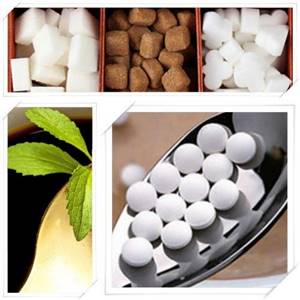
There are a lot of artificial sugar substitutes, their range is increasing every day. The composition and dosage can be read on the product label. Most often they come in the form of tablets and are conveniently packaged. Most popular:
- Sucralose is extracted from regular sugar and is considered the safest of all alternative sweeteners. Its glycemic level is 0, it does not affect the level of insulin in the blood, it is 600 times sweeter than sugar and has no calories.
- Aspartame is 160-200 times sweeter than sugar, energy value is 40 calories per 100 grams, it is not recommended for use in cooking when long-term heat treatment is used.
- Saccharin is approximately 400 times sweeter than sugar and contains 20 calories per 100 grams of product. Several decades ago, there was a popular theory about the dangers of this product, which was refuted by progressive research.
Natural sweeteners are also available in a wide range, the main ones being:
- Fructose is a product extracted from fruits. It is 2 times sweeter than sugar, the glycemic index is 20, 100 grams of the product contains 35 calories, which is almost the same as sugar, but since less is needed, this affects the energy value of dishes or drinks.
- Sorbitol is extracted mainly from rowan berries, apples and apricots. Sugar is 2 times sweeter, but being an alcohol in its structure, it does not affect insulin in the blood. Calorie content 100 grams - 24 calories.
- Erythritol - extracted from melons. Low in calories, does not affect insulin levels in the blood, less sweet than sugar. To replace 10 grams of sugar, you need 7 grams of erythritol.
- Stevia - obtained from the leaves of the stevia plant. 200 times sweeter than sugar, contains no calories. It has a specific bitter-copper taste. Whole stevia leaves are also used in drinks.
Is brown sugar healthy?
It is necessary to understand that it is not just the color and shape of a certain type of sugar that plays a role, but whether the original product has been chemically processed. The modern food industry can easily give a dark color and a pleasant aroma to highly processed sugar from cheap sugar beets or sugar cane residues - it's just a matter of marketing.
On the other hand, natural coconut sugar, which has a lower glycemic index, can be bleached through gentle processes - as a result, it will look like regular refined sugar and contain the same number of calories per teaspoon, while at the same time having a fundamentally different mechanism of action on metabolism a specific person.
Can the body exist without sugar?
Nutritionists and medical professionals are unanimous in their opinion that refined or brown sugar is not something healthy or necessary for the human body. But its excessive use, which occurs in literally every second case, has serious consequences and entails malfunctions of all systems. At the same time, a person needs natural sugars, which are found in natural products. Therefore, fruits, dried fruits and berries should be included in every person’s diet.
Interesting video:
Post Views: 2,298
Sugar substitutes
Even though sugar is the main source of glucose, in some cases it can significantly raise blood levels. In addition, the pancreas often suffers from eating sweets (from large amounts of sucrose), as a result of which the process of producing insulin necessary for normal functioning slows down. In this case, experts categorically prohibit eating sweet foods.
The number of calories in a teaspoon of sugar can be dangerous for the body, but substitutes contain no sugar at all. Undoubtedly, the body will react to the absence of a favorite product quite quickly, since the taste buds at first will not perceive substitutes for the usual sugar.
That is why it is recommended to wean yourself off this product gradually, despite the fact that initially it will be unpleasant or even painful, over time the taste buds will no longer sense the absence of sugar.
Knowing how many calories are in a spoonful of sugar, you must realize that in order to part with extra pounds and reduce waist inches, you need to completely or partially stop consuming it.
What is refined sugar?
Refined table sugar is a chemical product that has been processed and purified as much as possible from any impurities (including traces of minerals and vitamins). The white color of such sugar is achieved by bleaching - initially, any natural sugar has a dark yellow or even dark brown color. The texture of granulated sugar is also usually artificial.
In most cases, the source of raw materials for refined sugar is cheap sugar beets or sugar cane residues, which are unsuitable for producing brown cane sugar. It is also important to note that the food industry does not use refined sugar to make sweets, desserts and carbonated drinks, but an even cheaper product - fructose syrup.
Glucose-fructose syrup
Glucose-fructose syrup is a chemical used as a cheap sugar substitute in the production of industrial sweets. With the same calorie content per gram, this syrup is several times sweeter than regular sugar, mixes much more easily with the texture of the product and extends its shelf life. The raw material for fructose syrup is corn.
The harm of glucose-fructose syrup to health is that it has a much stronger effect on the human brain than natural sugar, as if provoking addiction to an excessively sweet taste. It also sharply increases blood glucose levels, provokes excessive insulin production and, if consumed regularly, creates a risk of developing diabetes.
Benefits and harms
Sugar powder is an easily digestible carbohydrate with a high calorie content that charges the human body with energy. Sucrose is broken down into glucose and fructose. Glucose becomes a participant in the synthesis of sulfuric acid, activates internal organs, promotes the production of insulin and hormones of happiness and joy. If we consider the biological nutritional value and calorie content of white carbohydrate, then its fat and protein content is zero. Excessive sugar consumption can lead to obesity, the development of caries and other dental problems, and calcium and mineral deficiency in the body.
